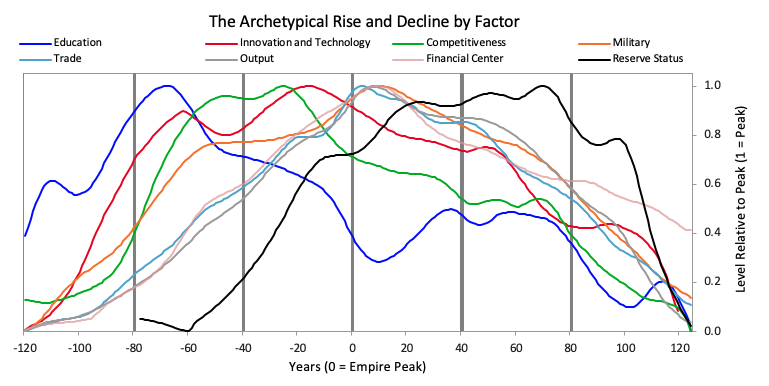Who is Ray Dalio ?
Ray Dalio, an American financier, founded Bridgewater Associates in 1975, which became the world’s 2nd largest hedge fund with assets of $196 billion in March 2023. The fund anticipated the subprime crisis in 2007 and has a strong presence in emerging markets, particularly China. Like any hedge fund, Bridgewater’s strategy incorporates all asset classes (equities, bonds, commodities, etc.) as well as a range of derivatives to manage price volatility in the financial markets. Dalio’s strategy, summarised in “The Changing World Order”, is also based on macroeconomic and extra-financial indicators, such as geopolitics. This book has had a profound effect on me, and I believe that Dalio’s thesis should be known beyond financial insiders.

Introduction
Ray Dalio began writing this essay in 2020 with three observations:
-From an economic point of view, the co-existence of levels of public and private debt never reached in peacetime, the maintenance of zero interest rates and money printing through asset purchases (quantitative easing), since the bursting of the subprime bubble in 2008, with an acceleration of these trends following the covid.
-From a socio-political point of view, a level of political division in the United States not seen since the American Civil War, combined with wealth inequality comparable to the years preceding the great financial crash of 1929.
-From a geopolitical point of view, the rapid development of a serious global competitor to the United States, China, leading to tensions not seen since the Cold War.
Ray Dalio therefore embarked on an in-depth analysis of the political, geopolitical and economic history of the last 500 years in particular, i.e. since the invention of capitalism, in order to identify similar cases. Ray Dalio, noting the recurring patterns of rise and fall of the great empires, sees history as cyclical, even though we consider the current period to be unique on our scale. His mission is to identify universal factors and establish a Big Cycle to predict the near future and guide wise financial choices.
The first part of the article sets out the key factors of the Big Cycle, including a focus on the debt and currency cycle. The second article summarises the application of Dalio’s model to the last three great empires: Dutch, British and American. The central and most relevant part analyses the current fate of the American Empire and the West. Dalio sees it as having reached the end of its great monetary cycle since 1945, faced with the emergence of China as a global competitor.
Ray Dalio observes that over the centuries, the pursuit, accumulation and distribution of wealth and power has been the main force influencing the lives of nations and the individuals who make them up. It is a fact that individuals and, above all, their governments, fight and organise themselves for wealth and power, and that nations rise and fall according to this level of wealth and power.
Ray Dalio distinguishes 18 factors that determine the level of wealth and power of any political entity (nation, empire, city-state) over time. I’ll just mention the 8 main ones:
-level of education
-competitiveness (measured by productivity per capita)
–technological innovation (products and production processes)
–per capita production (GDP)
–% of world trade
–military power
–importance of financial centre
–existence of a reserve currency
As a reminder, a reserve currency is a currency used by most countries for commercial and financial transactions. The least risky asset – a government bond – expressed and issued in this currency is often the most sought-after asset on the market because there is very little risk that the most powerful country in the world – the one holding the reserve currency – will default on its debt. The country that has developed a large reserve currency therefore has the privilege of easily financing its spending by issuing debt.
The Ascension
I have presented these factors in this order because the development of the first factor leads to the development of the second, which in turn leads to the development of the others, and so on. Each factor influences the other, amplifying the overall trend – towards improvement or deterioration. The result is the Big Cycle, which can be summed up as follows:
The ascent: In a given country, an elite and competent institutions put in place policies to improve the level of education of at least part of the population. By education Dalio means technical skills, but also a certain ethic: valuing work and study, respect for the law, willingness to cooperate with other citizens…
…This level of education led to a wave of innovation in products and production processes, supported by a spirit of cooperation and openness to change. Very quickly, the people of this country are producing more with the same amount of resources, productivity is rising and so is their competitiveness in the export market…
…As a result, the country’s share of international trade and its total output (GDP) grew. As the country’s technology becomes more advanced and its commercial interests grow, it modernises and increases its military strength to protect itself and even conquer/deter other countries.
Each factor influences the other: for example, higher tax revenues and higher per capita income lead to higher spending on education and infrastructure, which in turn increases the level of education and innovation…
The Summit
The country thus reaches the peak of its wealth and power, which corresponds roughly to the maximum level reached by each of these factors measured on a scale of 0 to 1.
During this period, and later, the country’s financial markets develop as its wealthiest citizens seek to invest their savings and producers have growing investment needs. Eventually, the country develops a reserve currency. It should be noted that these last two factors cannot really be applied to political entities predating capitalism, i.e. pre 1500.
Ray Dalio explains that the roots of decline lie in the conditions of prosperity:
-When a country becomes richer, wages and the price of everything rise quite naturally, which eventually leads to a drop in competitiveness, a drop that is reinforced by the fact that other countries import and copy innovations, so catching up.
-The level of education reaches a ceiling and, on the whole, people quite naturally enjoy a gentler way of life that leads them to study less, to value leisure over work, consumption over savings and so on.
-Above all, a rich nation is infinitely more unequal than a poor one. At this stage in a country’s development, income disparities have become significant, particularly in a country that has opted for capitalist institutions. In this type of country, financial markets and the circulation of savings are more developed, so the richest people have more opportunities to reinvest their income, which increases their wealth tenfold. At the same time, this upper class influences the choices of those with political power, the political class, and strengthens its position through a variety of strategies (private education, etc.).
-Growth is increasingly financed by debt, as the rich at the top use debt as leverage to increase the profitability of their investments, while the poorer classes want to maintain their lifestyle by buying on credit.
All in all, two powerful feelings dominate this society:
The future will be more or less as abundant as the present, which drives people into debt.
Because of the gap in incomes and access to education, citizens of the same country have increasingly different values, which leads to social conflict as soon as salaries stop rising in absolute terms.
The decline
The pace and intensity of economic and financial crises increased with the bursting of credit bubbles. As we shall see in more detail later, the government prefers to print money to pay its debts or those of its private agents rather than default on the debt. The crisis and the ensuing economic slowdown are exacerbating inequalities and creating new inequalities, because we now have to distribute the slices (income) from a shrinking cake (GDP). Class struggles over the distribution of wealth are fuelling the rise of other tensions of a religious, ethnic or cultural nature, which combined are leading to the development of populist political factions on both the left and the right. Overall, political extremism is on the rise, the gap in values between the country’s citizens is widening and authoritarianism is winning out over concerted, consensus-based decision-making. This downward cycle culminates in a political revolution that may even lead to civil war.
All countries experience this downward phase, which corresponds to a free fall in all the factors of wealth and power mentioned above.
Below is a graph of the factors explained above, and their evolution over time in relation to a 0 point, which corresponds to the country’s peak of power.

When the country in question is a major power with a reserve currency, these other events can be added to the downward phase of the cycle:
Dalio describes a pattern where a declining power faces the emergence of a rival exploiting its weaknesses. This leads to an increase in military spending, even in difficult economic times, temporarily supported by the maintenance of its reserve currency, a major source of funding.
Relations between these powers evolve through gradual conflicts, ranging from trade wars to monetary, technological and ideological confrontations, through to direct or indirect conflicts via intermediary states. History shows that the law of the strongest often determines who will rule the world for decades to come, relegating other modes of international management, such as international law, to the sidelines. In the event of military defeat during a period of internal political revolution, the currency of the declining empire loses its privileged status. This causes an upheaval in the world order, affecting not only the nation concerned but the world order as a whole.
Below is a summary of the Big Cycle, specifically for a large nation with a reserve currency.

The Big Cycle can be broken down into three major cycles:
the internal socio-political cycle of the country under study, with, as we have seen, rising inequality at its heart.
the external geopolitical cycle, with the rise and fall of major powers leading to a new world order.
the cycle of money, debt and growth, the most fundamental, which I will look at next.


Leave a Reply